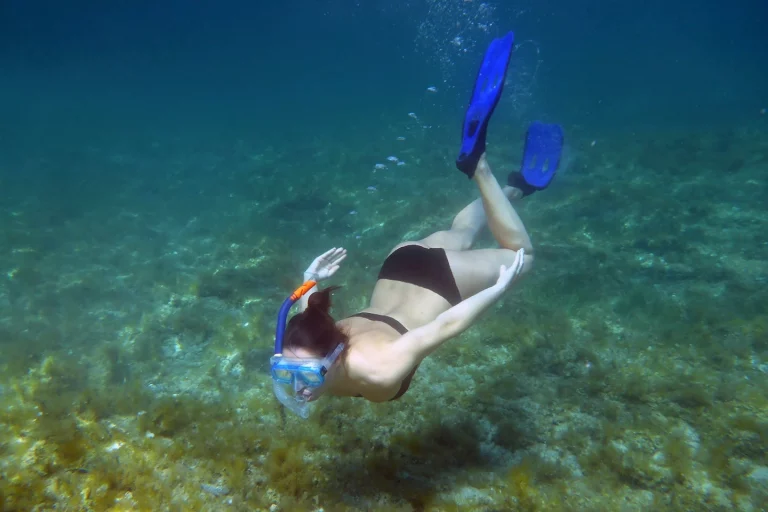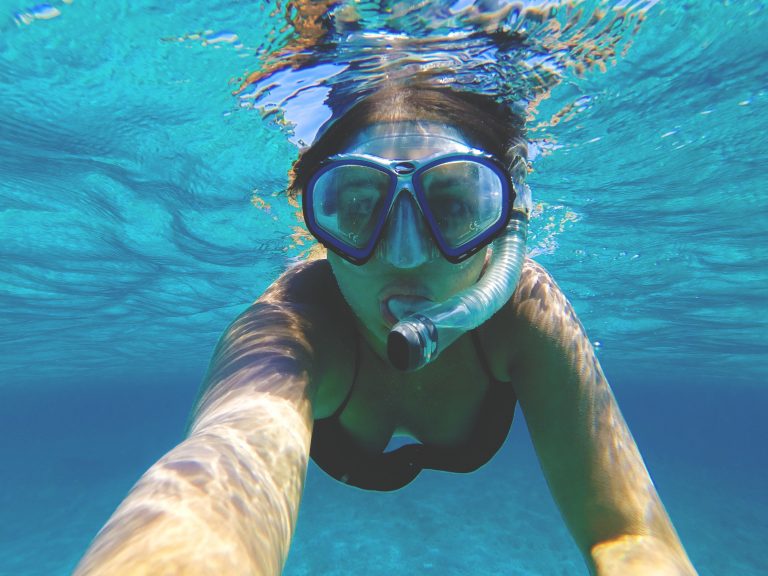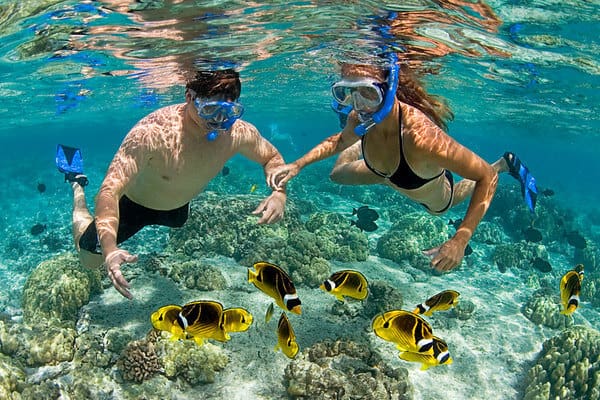Do you love the ocean and its wonders? Do you want to see the colorful corals, the amazing fish, and the unforgettable sights under the water? Then snorkeling is the perfect activity for you! Snorkeling is a popular and easy way to explore the marine world, with more than 8 million people in the USA enjoying it every year.
Snorkeling is also very affordable and simple, unlike scuba diving, which requires more training and equipment. Snorkeling only needs a few basic items, such as a mask, a snorkel, and fins, and you are ready to go!
But before you dive in, you might have some questions about snorkeling, such as:
- Is snorkeling dangerous?
- What equipment do I need?
- How do I snorkel?
Don’t worry; we have the answers for you in this guide. Read on and learn everything you need to know about snorkeling and how to make the most of your underwater adventure.
Quick Answer: Is Snorkeling Dangerous?
There is some danger involved in snorkeling. Snorkeling carries several serious risks that have resulted in deaths, including but not limited to solid currents, heart problems, drownings, weather changes, marine life, underwater items, equipment malfunctions, and others.
Snorkeling may appear to be a little odd, especially if you were born landlocked (like me!) That are all excellent inquiries to ask before diving in.
In this post, we’ll focus on the first question (“is snorkeling dangerous?”), but we’ll also include additional resources at the end to assist with answering questions regarding how to get started with snorkeling if that’s something you’re interested in.
Is Snorkeling Dangerous? Risks, Mistakes, and Safety Tips

Snorkeling is usually a safe and enjoyable experience when basic precautions are followed. Suppose you have certain health conditions such as asthma, epilepsy, cardiac disease, or panic attacks. In that case, however, discussing your options with your doctor is always suggested before getting in the water.
Dangers can be reduced by preparation, just like in any other sport. Make sure you have the right equipment and size to fit your body. A few lessons and practice sessions in a pool or additional tranquil water will also aid your readiness for the event.
But let’s get to our list!
12 Dangers of Snorkeling & How to Stay Safe
The following is a list of the most prevalent snorkeling risks and how to avoid them:
1. The Sun
Any outdoor activity exposes you to potential dangers. However, when splashing about in cold water, we frequently overlook the harmful effects of too much sun exposure. It matters not your age or skin tone; the exposure time determines the danger.
However, fair-skinned individuals are at a greater risk of injury and should take additional safety measures.
Sunburn is never desirable, but extended exposure might cause sun poisoning, resulting in skin blisters, a headache, fever, edema (swelling), nausea, and dizziness. Sun poisoning’s effects may last ten days to two weeks, spoiling anyone’s beach holiday.
Sunscreen is strongly recommended, and it should be a water-resistant variety. It’s also a good idea to apply sunscreen once or twice a day, as directed by the product. Wet suits or rash guards can also help prevent sunburn by protecting against solar radiation toxicity. When it comes to sun damage, eye injuries are also a worry.
Overexposure to UV radiation can harm the cornea of the eyes and cause blurry vision. As a result, you should always carry sunglasses with high-quality UV protective lenses when outside of the water.
2. Overheating
In the same vein as sun exposure, it’s critical to discuss how the body can get overheated; this isn’t typically what you think of when doing a water sport, but it’s a real risk.
The further south you go, the warmer the water temperature will become; this allows the body to be exposed to potential overheating. The body may also heat up faster if you wear a wet suit for protection against additional hazards.
Overheating makes blood flow to the skin higher, forcing the heart to work harder; this can also induce dizziness and nausea, which you don’t want while underwater. Overheating can result in heat stroke, potentially fatal on dry land but may be deadly in a watery setting.
It’s critical to take frequent rests while diving in warmer seas and to be aware if you’re feeling overheated.
3. Dehydration
When it comes to water sports, getting enough water is easily overlooked.
Swimming utilizes more muscles than any other outdoor activity, making snorkeling a demanding sport. As a result, the body must be hydrated; and you don’t want to swallow too much salt water.
Take enough water with you on your trip; stay hydrated even if you don’t feel thirsty! Sports drinks are an excellent alternative.
4. Exhaustion
Snorkeling is a demanding sport, full of sights and experiences that will cause you to forget how tired you might be.
Exhaustion can suddenly strike, and being out on the water is the last place you want to become tired, especially if you are far from land. Take many rests while swimming and permanently save enough energy for the swim.
It’s also critical that you get enough sleep before going snorkeling. You should also be in good physical condition before doing something like this. If you aren’t used to regular exercise, you may experience increased fatigue while swimming.
4. Cramps
In the water, muscular cramps are highly hazardous, the waves are more difficult to battle, and painful cramps may make you flail about.
Cramps are more common when the muscles are fatigued, so avoiding exhaustion is essential. Not getting enough water can also lead to cramps, so staying hydrated is beneficial.
The body also requires salt to prevent this condition, but that does not imply you should gulp down mouthfuls of saltwater if you can help it! Most sports drinks on the market include a reasonable amount of salt to prevent cramps.
Muscle cramps can also result from a lack of carbohydrates, so be sure that your diet is balanced before attempting snorkeling.
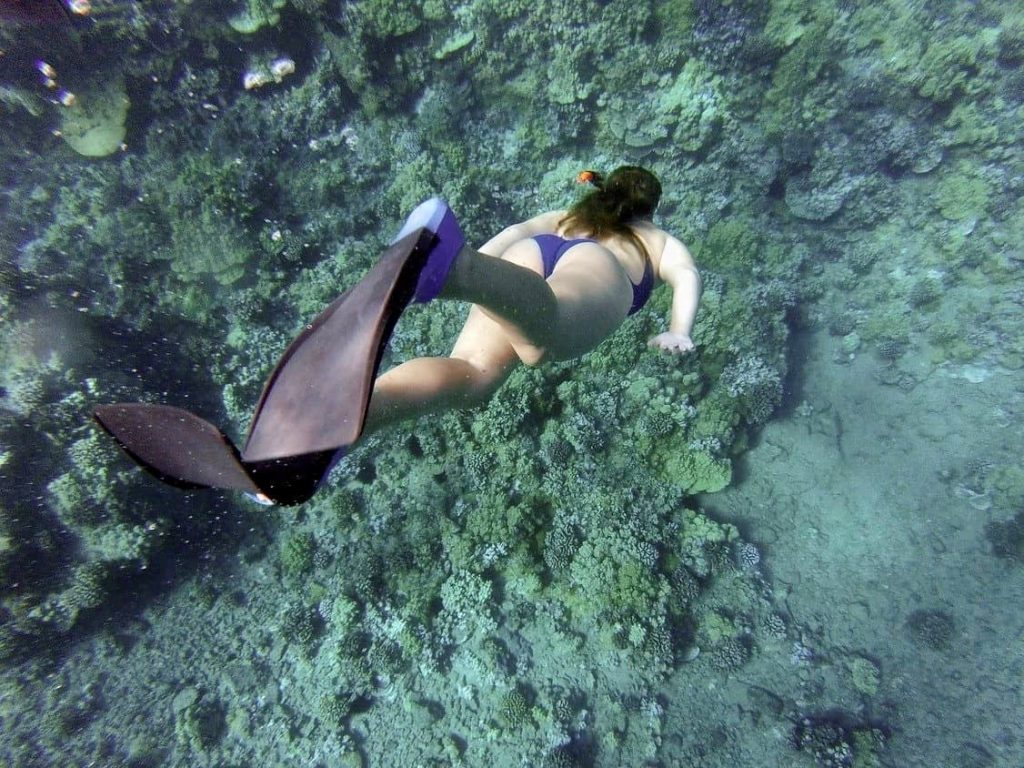
5. Cables, Wires, Nets, and Fishing Line
Many of the problems in our seas are due to human activity. Many sea hazards result from littering and irresponsible fishing practices, significantly threatening marine life.
We also go snorkeling in areas where ocean wrecks and other mishaps have occurred, generating detritus that washes up on the beach or into regions where we swim.
When snorkeling, it’s crucial to keep your eyes open and be vigilant about your surroundings. Snorkeling is also significant to enjoy through observation rather than poking and prodding in the sand to discover what you can dig up.
This sort of usage is prone to cuts, snags, and scrapes. Always be a no-touch snorkeler; even the gentlest contact might harm years of coral growth. Leave the marine environment in the same place you found so the next person can enjoy it.
It’s straightforward to become tangled in a fishing line abandoned on the sea bed; this might immobilize a diver or drag you under the water. Fishing lines can also be floating in the water, so don’t get so caught up in what’s happening around you that you aren’t paying attention.
6. Coral and Sharp Rocks
The ocean floor may be strewn with sharp rocks, as can other floorings. If you don’t pay attention, brushing up against these surfaces might result in nasty gashes if you’re not careful, so keep an eye out for pebbles on the sea floor and stay cautious at all times.
Corals are among the most stunning sights in the world’s oceans and one of the reasons why so many people enjoy snorkeling. On the other hand, the glories of coral reefs come with risks that must be respected.
The coral is delicate, so touching it can harm or even destroy it. Corals are living organisms, and certain types of coral, such as fire coral, may produce potent stings.
Coral is not only difficult to remove but also abrasive, as I’ll explain in a moment. It’s not just that coral can be sharp; it’s also hard to cut through because it’s usually denser than you’d think. You should keep this in mind if you plan landscaping with artificial corals.
Finally, let’s not forget that various fish and other sea creatures frequently inhabit coral. Some of this wildlife is also poisonous to humans and may be able to sting,
Some of these animals, especially the bees and stinging jellyfish, can produce similar symptoms to those seen with coral. They might be very unpleasant, possibly forcing you to cancel your holiday.
7. Marine Life
The oceans are teeming with marine life and, like coral, might be one of the reasons why snorkeling is so pleasurable in the first place. Although viewing sea creatures in their natural habitat is fascinating, it presents dangers if you don’t take appropriate precautions.

Of course, when it comes to hazardous aquatic life, sharks are typically the first thing that springs to mind; this may come as a surprise to you, but shark attacks on people are pretty uncommon. If you aren’t doing anything to anger a shark, they will most likely avoid you, as a rule.
Avoid wearing bright jewelry and other gleaming materials, as this may appear like a glittering fish scale to a shark. They are predators that will look for something to eat. Some people have been injured by getting shark bites while feeding other fish in the presence of sharks.
However, there’s a catch: if you spot a shark, the best option is to get out of the water immediately. However, I don’t do that, having dived with sharks numerous times.
Some other marine life that may pose a threat are:
- Jellyfish/Portuguese Man o’ War – The Man of War is a jellyfish species closely linked to the jellyfish. The Portuguese Man of War and the Jellyfish have long tentacles with stinging cells that can be painful when an unaware swimmer touches them. Despite their lack of aggressiveness, these tentacles may still entangle a careless snorkeler.
- Stingrays – These stingrays are not violent animals when unprovoked, but if cornered, they will attack humans. Their barbed tails contain extremely painful venom. Stingrays may bury themselves in the sand to blend in or search for food. They’re tiny and easily overlooked, so stepping on or putting a hand on them is a frequent snorkeling mistake that will most often result in a string.
- Sea Urchins – Sea Urchins are not quarrelsome species. They, however, have spines on their bodies that may be painful if touched or brushed against. These spines may cause an unpleasant surprise for a careless diver who comes in contact with them. They can even get through a diver’s wetsuit if they are not paying attention.
- Barracuda – These are similar to sharks because they are predatory animals that seldom attack people. They may also mistake bright materials for fish scales, triggering an attack. Barracudas have numerous very sharp teeth, which, if gnawed on by a diver, might result in severe damage, so stay away and don’t offer other fish while they’re present.
- Lionfish – These are incredibly stunning fish with beautiful featherlike quills. You may be inspired to touch them, but if you do, you’ll get a nasty neurotoxin that might induce an adverse response or even cause paralysis. The bright quills are excellent camouflage in coral reefs, making accidental contact likely.
- Triggerfish – Most fish are shy of people, as is the case with certain species of Triggerfish. Other species, like the Titan Triggerfish, are highly aggressive and will defend their territory. They do have teeth, and if they feel threatened, they will bite and butt at anybody who comes near their home.
- Lobsters/Crab – Crabs and lobsters are not dangerous to most divers. However, it is essential to point out that these creatures have powerful pinchers that can cause a lot of agonies if you inadvertently touch them or get trapped in one.
- Remoras – Again, these animals are generally not a threat to divers, and they ride on other aquatic creatures like sharks or sea turtles and hitchhike. Nevertheless, they will seek a host when not linked to another animal and cling to anything moving. They’re mostly just a pain to scuba divers, but their sucker-like mouths can result in a scrape if they get attached to the body.
When seeing sea creatures, the essential thing to remember is to be cautious of your surroundings, keep your hands off them, and avoid giving the fish anything!
8. Boats and Buoys
Snorkelers must also be cautious of objects on the water’s surface, which can cause injury. It would be best to be careful of boats and buoys while snorkeling because much of the pleasure comes from looking at things while treading the surface.

Buoys are a firm fixture along the coast, and you might believe they’d be challenging to miss. They’re generally moored on the bottom, with the buoy sitting on top. The chains and buoys are frequently constructed of steel, making them very easy to hit your head against as you flip over on the water’s surface.
It’s easy to overlook something as you swim, especially if you swim at a fast pace. You may not notice these objects until it is too late, so be conscious of your surroundings.
Boats and jet skis are also a hazard. A swimmer who is just slightly underwater is difficult for a boat to detect. Therefore it’s a good idea to use a dive flag while snorkeling. It’s also beneficial to only snorkel in locations where the activity is permitted.
9. Drowning
Drowning is dangerous with any water sport, but snorkeling may be particularly hazardous when you breathe through a tube that gets immersed.
It may be beneficial to try snorkeling with swimming gear before going in the water. Snorkel classes teach you how to breathe correctly when snorkeling. Some snorkels have “dry tops,” little caps that attach to the top of your mouth and prevent water from getting inside while you’re under the surface.
A one-way valve closes when you dive under or if a wave crests over the top of the snorkel. If your snorkel isn’t a “dry top,” you’ll need to learn how to keep water out of it.
9. Equipment Failure
When dealing with snorkeling, as with any other activity, the equipment has the potential for error. However, when you’re in the water, this may be deadly.
Rental equipment is available for charter snorkeling vacations. While most of the time, this is safe, it’s still a good idea to bring your gear. This way, you’ll know what condition everything is in, whether it fits you, and who used it before you.
Goggles can also fog up or leak underwater. Always double-check that the goggles are correctly adjusted. A mixture of baby shampoo and water may be an inexpensive solution to prevent the lenses from becoming foggy.
10. Currents
There are various currents in the ocean that no other body of water can compare to. Water current changes may help you stay safe while swimming.
The movements of the water beneath the surface are sometimes complex to discern from the beach’s surface. When waves come to shore, the water behind them will create an undertow or flow on the ocean floor, flowing back to the sea.
Knowing how ocean currents operate may help you stay safe while snorkeling. Local knowledge can provide helpful information on water flow patterns. Most significantly, however, be prepared to encounter shifting water flow while you swim.
How to Reduce Snorkeling Risks – Safety Tips
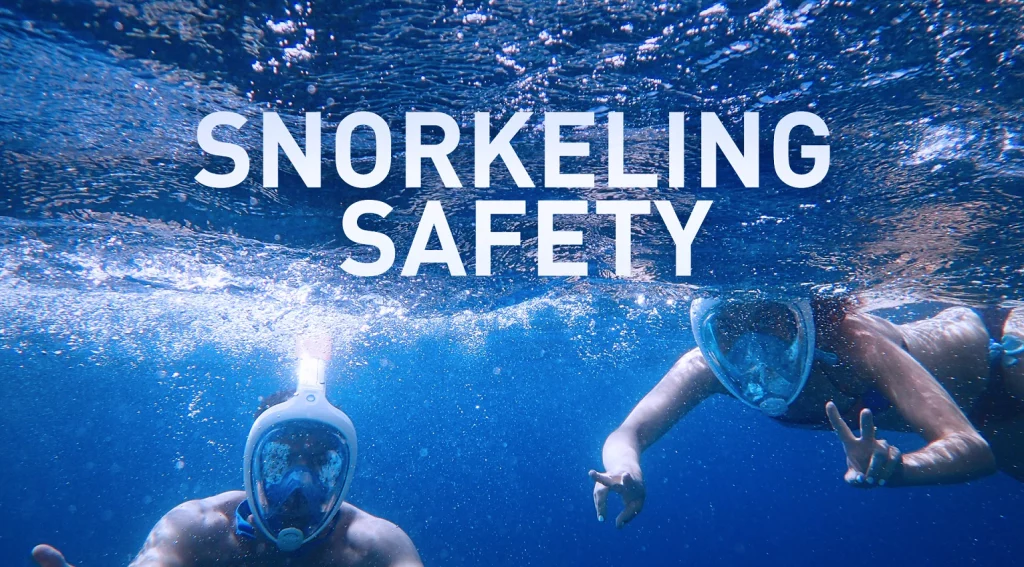
Let’s have a look at the safety of snorkeling.
Everything that necessitates us to get out of bed in the morning comes with some level of danger, and snorkeling is no different. We want to know the risks and whether they make snorkeling too risky.
Let’s be honest. Snorkeling poses specific hazards. Official risks of snorkeling include strong currents, heart problems, drownings, weather circumstances, marine life, underwater items, equipment malfunctions, and other issues that have killed people.
However, snorkeling is a very safe activity. Serious events are uncommon. According to Snorkeling Australia, there are an average of 11 snorkeling deaths each year across the continent, with over 2.2 million snorkeling dives on the Great Barrier Reef alone in 2007. “Reports of injury from snorkeling are rare,” says the study, and it can be deemed a safe activity. [Source]
Is snorkeling dangerous? Snorkeling has risks, including natural dangers from ocean currents, objects in the water, or marine life. Still, most of them may be reduced by using safe water, utilizing correct equipment, and following established planning, training, health, and safety procedures.
Because there is always a possibility that something could go wrong, we want to do everything possible to make snorkeling as safe as we can while on the water. Being cautious pays off, allowing us to focus more on the fantastic experience that snorkeling can provide!
To properly learn hands-on snorkel safety, we always advise inexperienced snorkelers to take a snorkel class or tour from a certified instructor. As an added benefit, while by no means comprehensive, here are our suggestions for an excellent location to get started planning for your class or trip.
Be Honest About your Swimming Ability.
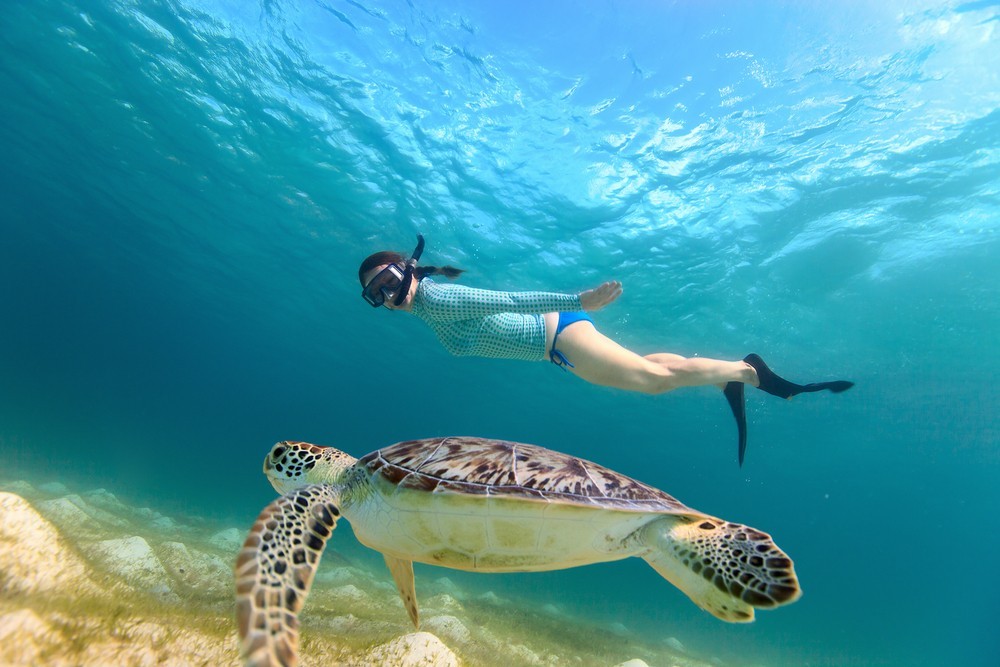
When swimming, most of what you’re doing is basic open-water swimming. It’s no surprise, then, that snorkeling requires the most expertise.
It would be best if you were completely honest about your swimming ability, especially in the ocean. Swimming in the sea with currents, waves, and other factors to consider is a unique experience. A pool does not mean that confident swimmers in a pool can’t feel uneasy in the sea.
If you can swim well and unaided in ocean conditions without difficulty, you’ll be able to snorkel up quickly. However, if that’s not the case for you, consider utilizing flotation to keep yourself above water safely. You Can read our informative article about Can I snorkel if I can’t swim?
Use Flotation if You Need It.
Beginners (and they are occasionally needed for everyone on tours in certain countries like Mexico) can use a life jacket to enter the water to snorkel at first.
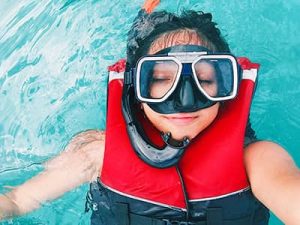
So, suppose you aren’t snorkeling. If you’re not confident in your ocean swimming ability, it’s a good idea to wear a life jacket to learn and improve more safely (and you’ll undoubtedly be alone).
If you’re still working on your swimming ability, it’s advisable to start with a snorkel guide who can show you everything you need to know about snorkeling.
Most snorkeling trips will be able to supply a life jacket for you to use as well. Check out our complete article about Best Floatation devices that keep you safe?
Check Your Fitness & Health
Most of the relatively small number of deaths that occur while snorkeling is most likely related to an underlying health problem, such as a heart attack or stroke.
Snorkeling is an excellent form of exercise if you already can exercise safely. You genuinely do use your entire body to power against currents, control your direction in the water, and do other things that will invigorate your heart and lungs.
Always check with your doctor before snorkeling to ensure that you are physically able to do so, especially if you have any health concerns or issues.
Understand the Water Conditions
The ocean, while beautiful and powerful, can surprise even experienced snorkelers. New snorkelers may be startled by the raw power of water currents, waves, and other hazards, as well as expert snorkelers being swept away in rip tides and undertows.
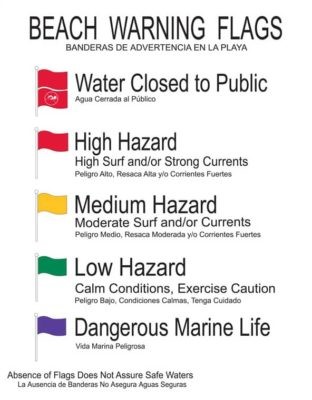
As a result, it’s essential to learn everything possible about the water before going in. If the water is nice, you’re much more likely to have a good time. If the water appears threatening, you’ll know not to return until later.
Beach warning flags are another excellent method to assess water quality. You’ll frequently find a little flag pole with various colored banners raised depending on the ocean’s condition.
A green flag indicates a safe environment, yellow caution is advised, red implies the water is deadly, and two red flags usually indicate the area is so complex that it has been closed.
Depending on where you are in the world, this may differ somewhat, so it’s never a bad idea to verify with someone, but globally, it usually holds.
Finally, strive for green-flag water conditions. If there are no beach warning flags, this does not guarantee safe water conditions; in those situations, you should get confirmation from someone qualified, like a lifeguard.
Avoid Dangerous Waters
While you should avoid dangerous water on yellow- or red-flag days, it is also essential to avoid dangerous creatures like jellyfish and even specific algae.
If a purple flag is displayed on the beach warning flag pole, it implies that there is hazardous marine life in the area and swimming should be avoided. It’s also a good idea to inquire about the local waters. Perhaps a straying shark was observed recently.
Maybe there’s a submerged rock outcrop you can’t see when the tide is high. Or maybe they’ll tell you about some spectacular underwater locations that you can discover on your own.
Use the Right Equipment
Although choosing the appropriate equipment for the task is always essential, especially when spending time in the ocean, there are particular distinctions between the beginning and more experienced snorkelers.
First and foremost, you’ll want a snorkel mask that fits firmly yet not too tightly. That one is the same for everyone, regardless of their snorkeling ability. However, the snorkel itself differs pretty significantly.
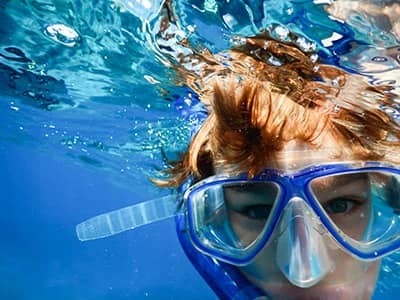
Traditionally, there was just one kind of snorkel: an open tube with a mouthpiece that joined your underwater mouth to the air above the water. That’s no longer our only alternative, however.
Bright people have created a “dry snorkel,” which looks identical to a regular snorkel but features a one-way valve on the tip to keep unwanted water out while allowing the user to breathe freely.
Dry snorkels have revolutionized the way beginning snorkelers enjoy their experience. They’ve made it easier for novices to focus less on controlling water in their tubes and more on snorkeling well and having fun.
Dry snorkels are always a good idea for newcomers. (Even though dry snorkels significantly improve over traditional snorkels, they aren’t 100% secure. As a result, keep your usual caution when submerged, even if water enters your snorkel tube.)
It’s an excellent dry valve and a super-helpful purge valve that allows you to blow any stray water that does fall into your snorkel out the bottom of your mouthpiece. Our top dry snorkel is the Oceanic Ultra-Dry 2 (Amazon) (which we’ll get to in a moment). The mask is lightweight and well-made, but it’s also comfortable to wear due to the mouthpiece.
Finally, utilizing fins is a great plan. They allow you to go farther, quicker, and see more while on the water by allowing you to move faster and use less energy. When selecting the best snorkeling fins for you, there are a few factors to consider. You’ll want to ensure you’re using fins designed for regular swimming (and not something like free diving) since those fins will be more manageable for novices.
The Mares Avanti Superchannels (on Amazon) are our top picks for beginning snorkelers’ fins. They utilize some more complicated fin technology without necessitating the higher prices of more fully-developed fins, achieving a nice balance for novices. (Check out your best options for snorkel fins by reading The Best Snorkel Fins for Beginners, Advanced Snorkelers & Travelers.)
If you want extra flotation (through a life jacket or snorkel vest, a lighter-duty life jacket), ensure it fits securely and doesn’t pull up above your chin when fastened and lifted from the shoulders.
Finally, you should have no trouble snorkeling comfortably in tropical seas wearing just a swimsuit, but as the water cools, your body heat dissipates. So if you’re snorkeling in colder or even cold water, make sure you have a wet suit that is suitable for the conditions. (Check out our guide on getting started with snorkel gear, What Snorkel Gear Should I Buy? Full Guide to Started Affordably.)
Know How to Use Your Equipment

Now that you’ve got everything you need, be sure you know how it works. Take some time to examine how everything fits together and adjusts and anything else that comes to mind.
Make sure everything fits before trying it on.
Your mask and snorkel should fit securely but not uncomfortably, and your snorkel’s mouthpiece should rest comfortably in your mouth at a distance that allows it to connect firmly to your mask strap. Your fins and life jacket should be secure yet not too tight.
Then, take a test snorkel to check out your gear in a safe, shallow location. Glide for a while to see how everything feels and ensure you don’t discover any unexpected leaks in your mask or snorkel.
Return to the beach and make any necessary adjustments.
Practice Getting Rid of Water
One of the essential skills to master to snorkel more safely is dealing with unexpected water in your mask and your snorkel tube. Any intruding water will be less common, but it does occur with a well-fitting mask and a dry snorkel.
A few drops of water in your best snorkel mask are rarely enough to spoil your dive, but if you do end up with too much, you’ll need to clear it. Some masks include a purge valve on the side of the mask that allows you to keep the mask firmly pressed against your face and breathe out through your nose to force any obstruct
If your mask doesn’t include a purge valve, the most straightforward method to empty it is simply to swim so that your head is above the waterline and lift the bottom of your snorkel mask, wiggle it around a little, and let the water run out of your mask.
Many snorkels include their type of purge valve, such as our top choice, the Oceanic Ultra-Dry 2 (Amazon). It’s usually a tiny reservoir that extends beyond the bottom, where the tube curves toward your mouth. This reservoir catches any water that inadvertently enters the snorkel and allows you to blow into it to expel water from the bottom of the purge valve.
Swimmers who don’t have purge valves will need to tread water with their heads above the water surface, then tilt their heads back slightly (but not so far that the tip of their snorkel touches the water behind them) and blow strongly out of their snorkel tube.
Now that the water is out of your snorkel, it’s time to replace the top part. Take some practice time in the shallows with whatever type of mask or snorkel set-up you have to learn how these water-ejection processes work. Because the snorkeler was caught off guard by the water and was not prepared to deal it, many of the issues that occur while snorkeling can be avoided.
Snorkel With a Buddy Group

The most common snorkeling mistake that tourists make is to swim by themselves. Instead, always snorkel in a group with a buddy who will keep an eye on you and your partner.
If you have a problem and are alone, you’ll be stuck. However, suppose you detect an issue and have a buddy keeping an eye on you (and vice versa). In that case, they can notify the larger group, resulting in many more individuals ready to assist.
For both beginners and seasoned snorkelers, snorkeling with a group is critical. Make snorkeling an enjoyable experience by making it a social event.
Keep Visual Contact
When snorkeling with a buddy and a group, keep an eye on them! Make sure you can see one another and that they can see you. The buddy group dynamic is ineffective if you get too far apart to view one another.
Keep an eye on land and the boat if you’re in open water to ensure you don’t miss your target. Getting so caught up in what you see below is simple that you can float away from your starting position without realizing it. It may result in you being separated from your group or ending up so distant that returning may be challenging. So, keep an eye on where you’re going by raising your head above water every few minutes.
Ask Locals About the Snorkeling
There’s only so much you can learn about a place by looking at beach warning flags or reading weather reports.
One of the most effective methods to get to know a place is to seek out those who reside there and appreciate the water as part of their everyday routine. Hotel concierges, dive shop owners, lifeguards, and other snorkelers or scuba divers can all be good sources of information. Most people are more than happy to share what they know about where some of the best places are.
Use the Proper Sun Protection
Sun protection is often an afterthought regarding snorkeling safety, but it’s critical. It’s not unusual to be in the water for more than an hour, and if you’re snorkeling with your back, neck, and shoulders pointing toward the sun without adequate sun protection, you can get seriously burned.

The first step is to choose a sunscreen that will be effective for snorkeling, implying it must be waterproof and safe for the reef.
It’s critical to apply a water-resistant sunscreen since if your sunscreen is washed off in a few minutes, it won’t do you much good. On the other hand, traditional sunscreens are a no-no because they contain chemicals that have been demonstrated to harm coral reefs and aquatic life [Source].
I’m a massive fan of the Alba Botanica Sensitive SPF50 (Amazon) sunscreen because it protects my skin, has an excellent SPF rating, is reef safe and biodegradable, and smells good.
We also recommend wearing a rash guard, an inexpensive, water-resistant shirt you may use in the pool with you. Rash guards are primarily used to protect your shoulders and back (which means you’ll use less sunscreen overall) and insulate your core a little if you’re in cooler water.
The REKITA Women’s Long Sleeve Rashguard (Amazon) is my favorite rash guard because it provides excellent sun protection while allowing me a full range of motion in the arms. One of my husband’s favorites is the Volcom Men’s Lido Solid Short Sleeve Rashguard (Amazon) because it provides excellent sun protection while providing a little more insulation for the arms and hands.
FAQs
Bottom Line
Snorkeling is an incredible way to get out and encounter the sea in a way that no other activity allows you to do, and it’s also a lot of fun. However, as with any activity, it has its dangers that are easiest to avoid if recognized upfront.
The game’s name is utilizing the correct equipment, picking safe snorkeling water, and following established preparedness, training, and health and safety precautions.
The chances of anything in life, including snorkeling, never being risk-free, and safety, are never certain, still by following the above strategies as a basis for further research and doing other things like taking lessons from a professional guide.
You can learn how to minimize those risks as much as possible and have a fantastic, safe time out on the water by starting small and practicing. Being honest with yourself about what you’re ready for (and not forcing yourself too far), and taking responsibility for what you’re ready for (and not pushing yourself too far).
That’s it for our detailed guide on Is Snorkeling Dangerous? I hope you find it helpful. Tell us about your experience in the comment section. Happy snorkeling!




